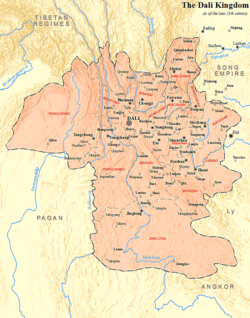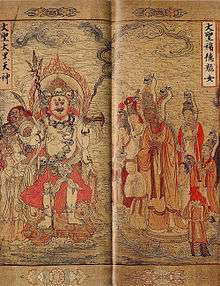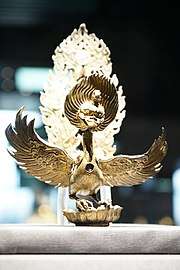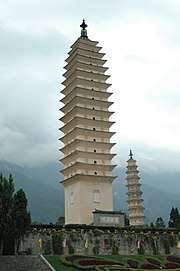Dali Kingdom
The Dali Kingdom, also known as the Dali State (simplified Chinese: 大理国; traditional Chinese: 大理國; pinyin: Dàlǐ Guó; Bai: Dablit Guaif), was a kingdom situated in modern Yunnan province, China from 937 until 1253 when it was conquered by the Mongols. Its kings continued to administer the area as Mongol vassals until the Ming conquest of Yunnan.[1]
Dablit Guaif 大理國 | |||||||||
|---|---|---|---|---|---|---|---|---|---|
| |||||||||
 Map of Dali Kingdom in late 12th century | |||||||||
| Status | Song dynasty tributary state (982–1253) | ||||||||
| Capital | Dali | ||||||||
| Common languages | Written Classic Chinese Bai | ||||||||
| Religion | Buddhism | ||||||||
| Government | Monarchy | ||||||||
| Emperor | |||||||||
• 937–944 | Duan Siping | ||||||||
• 1081–1094 | Duan Zhengming | ||||||||
• 1096–1108 | Duan Zhengchun | ||||||||
• 1172–1200 | Duan Zhixing | ||||||||
• 1251–1254 | Duan Xingzhi | ||||||||
| History | |||||||||
• Established | 937 | ||||||||
• Coup d'etat by Gao Shengtai | 1094 | ||||||||
• Reestablished | 1096 | ||||||||
• Ended by the Mongol Empire | 1253 | ||||||||
| |||||||||
| Today part of | China Laos Myanmar | ||||||||
| Dali Kingdom | |||||||||
|---|---|---|---|---|---|---|---|---|---|
| Chinese name | |||||||||
| Traditional Chinese | 大理國 | ||||||||
| Simplified Chinese | 大理国 | ||||||||
| Literal meaning | State of Dali | ||||||||
| |||||||||
| Alternative Chinese name | |||||||||
| Traditional Chinese | 後大理 後理國 | ||||||||
| Simplified Chinese | 后大理 后理国 | ||||||||
| |||||||||
| Bai name | |||||||||
| Bai | Dablit Guaif | ||||||||
History

Origins
Nanzhao was overthrown in 902 and three dynasties followed in quick succession before Duan Siping seized power in 937, establishing himself at Dali.[2] The Duan clan professed to have Han ancestry.[3] The Yuan dynasty records said the Duan family came from Wuwei in Gansu.[4]
Relations with the Song dynasty
Dali's relationship with the Song was cordial throughout its entire existence. Dali congratulated the Song dynasty on the conquest of Later Shu in 965 and voluntarily established tribute relations in 982. It was however essentially an independent state. At times the Song even declined offers of tribute.[2] The Song founder Song Taizu declared all land south of the Dadu River to be Dali territory and did not desire to pursue any further claims to avoid the Tang dynasty's disastrous efforts against Nanzhao.[5]
Dali's primary importance to the Song dynasty was its horses, which were highly prized and sought after as military assets, especially after the fall of the Northern Song. They were described by a Song official in the following passage:
These horses possess a shape [that is] quite magnificent. They stand low with a muscular front, very similar to the shape of a chicken. The diaphragm is broad, shoulders thick, waist flat, and back round. They are trained to squat on their rear ends like a dog. They easily climb steep terrain on command and possess both speed and agility in chase. They have been raised on bitter buckwheat, so they require little to maintain. How could a horse like this not be considered a good horse?[6]
Dazhong Kingdom (1094-1096)
In 1094, the former prime minister Gao Shengtai forced King Duan Zhengming to relinquish the throne to him and renamed the Dali Kingdom to "Dazhong Kingdom". Gao Shengtai ruled briefly until his death in 1096, after which the throne was returned to the Duan family. Duan Zhengming's younger brother, Duan Zhengchun, became the new ruler and restored the kingdom's former name.[7]
Fall
In 1252 Möngke Khan placed his brother Kublai in charge of invading Dali. In 1253 Kublai's army crossed the Jinsha River and received the surrender of Duan Xingzhi, who presented to Möngke in 1256 maps of Yunnan. Duan Xingzhi of Dali was enfeoffed as Maharaja (摩诃罗嵯) by Kublai Khan,[8] and the Duan royal family continued to hold the title of Maharaja in Yunnan as vassals to the Mongols under the supervision of Mongolian imperial princes and Muslim governors. The Duan family reigned in Dali while the governors served in Kunming. After the Ming conquest of Yunnan,[9] The Duan royals were scattered in various distant areas of China by the Hongwu Emperor.[10]
Yunnan under the Mongols

The Duan family governed Yunnan's various indigenous peoples for eleven generations until the end of Mongol rule. They willingly contributed soldiers to the Mongol campaign against the Song dynasty. In 1271, they aided the Yuan dynasty in putting down a Mongol rebellion in Yunnan.[10]
In 1274, Ajall Shams al-Din Omar was assigned by Kublai to stabilize Yunnan. He instituted a native chieftain system that came to be known as tusi which assigned ranks and posts to native chieftains. Under this institution of "rule based on native customs" the locals retained much of their autonomy with the exception of three obligations. One, they would provide surrendered troops to the Yuan government. Two, local chieftains would provide tribute to the Yuan court. Three, they would follow the rules of appointment, succession, promotion, degradation, reward, and punishment of native chieftains created by the Yuan court.[10]
Yuan rule also introduced a significant Muslim influence into Yunnan.[10]
The King of Dali Duan Gong was married to the Mongol Borjigin princess Agai, daughter of the Yuan dynasty Mongol Prince of Liang, Basalawarmi. They had a son and a daughter, Duan Sengnu.[11][12][13][14][15][16][17][18][19][20] their children were also called Duan Qiangna amd Duan Bao.[21] Duan Sengnu raised Duan Bao to take revenge against Basalawarmi for the killing of Duan Gong.[22][23] A play was made based on these events.[24][25] According to Yuan documents, the Duan family were originally Han Chinese from Wuwei commamdery, Gansu.[26][27][28] Other Duan families also originated from Wuwei.[29][30]
Conquest by Ming

In 1381, the Ming dynasty dispatched 300,000 troops to crush the Yuan remnants in Yunnan.
The House of Duan, who helped the Mongols against a Red Turban Rebellion attack from Sichuan, also fought against the Ming army. The ruler Duan Gong refused to surrender by writing to Fu Youde, making it clear that Dali could only be a tributary to the Ming. Fu Youdei attacked and crushed Duan Gong's realm after a fierce battle. The Duan brothers were taken captive and escorted back to the Ming capital. [31]
Religion
A version of Buddhism known as Azhali existed in Yunnan since the 9th century. The last king of Nanzhao established Buddhism as a state religion and many Dali kings continued the tradition. Ten of Dali's 22 kings retired to become monks.[32]
Governance
Under the influence of Chinese officials present from early times,[33] the Dali elite used Chinese script supplemented by Bai characters that were constructed based on Chinese characters.[34] The Dali court granted hereditary fiefs to pre-existing clan chiefs to win over support, as well as autonomous military divisions. Similarly to the Nanzhao military, the Dali military consisted of a standing army, townsfolk peasant-soldiers and indigenous militia.[35]
Family Tree of the Kings of Dali
| Family Tree of the Kings of Dali | |||||||||||||||||||||||||||||||||||||||||||||||||||||||||||||||||||||||||||||||||||||||||||||||||||||||||||||||||||||||||||||||||||||||||||||||||||||||||||||||||||||||||||||||||||||||||||||||||||||||||||||||||||||||||||||||||||||||||||||||||||||||||||||||||||||||||||||||||||||||||||||||||||||||||||||||||||||||||||||||||||||||||||||||||||||||||||||||||||||||||||||||||||||||||||||||||||||||||||||||||||||||||||||||||||||||||||||||||||||||||||||||||||||||||||||||||||||||||||||||||||||||||||||||||||||||||||||||||||||||||||||||||||||||||||||||||||||||||||||||||||||||||||||||||||||||||||||||||||||||||||||||||||||||||||||||||||||||||||||||||||||||||||||||||||||||||||||||||||||||||||||||||||||||||||||||||||||||||||||||||||||||||||||||||||||||||||||||||||||||||||||||||||||||||||||||||||||||||||||||||||||||||||||||||||||||||||||||||||||||||||||||||||||||||||||||||||||||||||||||||||||||||||||||||||||||||||||||||||||||||||||||||||||||||||||||||||||||||||||||||||||||||||||||||||||||||||||||||||||||
|---|---|---|---|---|---|---|---|---|---|---|---|---|---|---|---|---|---|---|---|---|---|---|---|---|---|---|---|---|---|---|---|---|---|---|---|---|---|---|---|---|---|---|---|---|---|---|---|---|---|---|---|---|---|---|---|---|---|---|---|---|---|---|---|---|---|---|---|---|---|---|---|---|---|---|---|---|---|---|---|---|---|---|---|---|---|---|---|---|---|---|---|---|---|---|---|---|---|---|---|---|---|---|---|---|---|---|---|---|---|---|---|---|---|---|---|---|---|---|---|---|---|---|---|---|---|---|---|---|---|---|---|---|---|---|---|---|---|---|---|---|---|---|---|---|---|---|---|---|---|---|---|---|---|---|---|---|---|---|---|---|---|---|---|---|---|---|---|---|---|---|---|---|---|---|---|---|---|---|---|---|---|---|---|---|---|---|---|---|---|---|---|---|---|---|---|---|---|---|---|---|---|---|---|---|---|---|---|---|---|---|---|---|---|---|---|---|---|---|---|---|---|---|---|---|---|---|---|---|---|---|---|---|---|---|---|---|---|---|---|---|---|---|---|---|---|---|---|---|---|---|---|---|---|---|---|---|---|---|---|---|---|---|---|---|---|---|---|---|---|---|---|---|---|---|---|---|---|---|---|---|---|---|---|---|---|---|---|---|---|---|---|---|---|---|---|---|---|---|---|---|---|---|---|---|---|---|---|---|---|---|---|---|---|---|---|---|---|---|---|---|---|---|---|---|---|---|---|---|---|---|---|---|---|---|---|---|---|---|---|---|---|---|---|---|---|---|---|---|---|---|---|---|---|---|---|---|---|---|---|---|---|---|---|---|---|---|---|---|---|---|---|---|---|---|---|---|---|---|---|---|---|---|---|---|---|---|---|---|---|---|---|---|---|---|---|---|---|---|---|---|---|---|---|---|---|---|---|---|---|---|---|---|---|---|---|---|---|---|---|---|---|---|---|---|---|---|---|---|---|---|---|---|---|---|---|---|---|---|---|---|---|---|---|---|---|---|---|---|---|---|---|---|---|---|---|---|---|---|---|---|---|---|---|---|---|---|---|---|---|---|---|---|---|---|---|---|---|---|---|---|---|---|---|---|---|---|---|---|---|---|---|---|---|---|---|---|---|---|---|---|---|---|---|---|---|---|---|---|---|---|---|---|---|---|---|---|---|---|---|---|---|---|---|---|---|---|---|---|---|---|---|---|---|---|---|---|---|---|---|---|---|---|---|---|---|---|---|---|---|---|---|---|---|---|---|---|---|---|---|---|---|---|---|---|---|---|---|---|---|---|---|---|---|---|---|---|---|---|---|---|---|---|---|---|---|---|---|---|---|---|---|---|---|---|---|---|---|---|---|---|---|---|---|---|---|---|---|---|---|---|---|---|---|---|---|---|---|---|---|---|---|---|---|---|---|---|---|---|---|---|---|---|---|---|---|---|---|---|---|---|---|---|---|---|---|---|---|---|---|---|---|---|---|---|---|---|---|---|---|---|---|---|---|---|---|---|---|---|---|---|---|---|---|---|---|---|---|---|---|---|---|---|---|---|---|---|---|---|---|---|---|---|---|---|---|---|---|---|---|---|---|---|---|---|---|---|---|---|---|---|---|---|---|---|---|---|---|---|---|---|---|---|---|---|---|---|---|---|---|---|---|---|---|---|---|---|---|---|---|---|---|---|---|---|---|---|---|---|---|---|---|---|---|---|---|---|---|---|---|---|---|---|---|---|---|---|---|---|---|---|---|---|---|---|---|---|---|---|---|---|---|---|---|---|---|---|---|---|---|---|---|---|---|---|---|---|---|---|---|---|---|---|---|---|---|---|---|---|---|---|---|---|---|---|---|---|---|---|---|---|---|---|---|---|---|---|---|---|---|---|---|---|---|---|---|---|---|---|---|---|---|---|---|---|---|---|---|---|---|---|---|---|---|---|---|---|---|---|---|---|---|---|---|---|---|---|---|---|---|---|---|---|---|---|---|---|---|---|---|---|---|---|---|---|---|---|---|---|---|---|---|---|---|---|---|---|---|---|---|---|---|---|---|---|---|---|---|---|---|---|---|---|---|---|---|---|---|---|---|---|---|---|---|---|---|---|---|---|---|---|---|---|---|---|---|---|---|---|---|---|---|---|---|---|---|---|---|---|---|---|---|---|---|---|---|---|---|---|---|---|---|---|---|---|---|---|---|---|---|---|---|---|---|---|---|---|---|---|---|---|---|---|---|---|---|---|---|---|---|---|---|---|---|---|---|---|---|---|---|
| |||||||||||||||||||||||||||||||||||||||||||||||||||||||||||||||||||||||||||||||||||||||||||||||||||||||||||||||||||||||||||||||||||||||||||||||||||||||||||||||||||||||||||||||||||||||||||||||||||||||||||||||||||||||||||||||||||||||||||||||||||||||||||||||||||||||||||||||||||||||||||||||||||||||||||||||||||||||||||||||||||||||||||||||||||||||||||||||||||||||||||||||||||||||||||||||||||||||||||||||||||||||||||||||||||||||||||||||||||||||||||||||||||||||||||||||||||||||||||||||||||||||||||||||||||||||||||||||||||||||||||||||||||||||||||||||||||||||||||||||||||||||||||||||||||||||||||||||||||||||||||||||||||||||||||||||||||||||||||||||||||||||||||||||||||||||||||||||||||||||||||||||||||||||||||||||||||||||||||||||||||||||||||||||||||||||||||||||||||||||||||||||||||||||||||||||||||||||||||||||||||||||||||||||||||||||||||||||||||||||||||||||||||||||||||||||||||||||||||||||||||||||||||||||||||||||||||||||||||||||||||||||||||||||||||||||||||||||||||||||||||||||||||||||||||||||||||||||||||||||
Art
Citations
- Theobald, Ulrich (17 August 2012), "Dali 大理", China Knowledge.
- Yang 2008a.
- Frederick W. Mote (2003). Imperial China 900-1800. Harvard University Press. pp. 710–. ISBN 978-0-674-01212-7.
- Bryson, Megan (2016). Goddess on the Frontier: Religion, Ethnicity, and Gender in Southwest China. Stanford University Press. p. 41. ISBN 1503600459.
- Heirman, Ann; Meinert, Carmen; Anderl, Christoph (2018). Buddhist Encounters and Identities Across East Asia. BRILL. p. 97. ISBN 9004366156.
- Herman 2007, p. 40.
- Bryson 2016, p. 38.
- Yang 2008c.
- Frederick W. Mote; Denis Twitchett (26 February 1988). The Cambridge History of China: Volume 7, The Ming Dynasty, 1368-1644. Cambridge University Press. pp. 144–. ISBN 978-0-521-24332-2.
- Yang 2008b.
- Lee, Lily Xiao Hong; Wiles, Sue (2015). Biographical Dictionary of Chinese Women, Volume II: Tang Through Ming 618 - 1644. Routledge. p. 5. ISBN 1317515625.
- Lee, Lily Xiao Hong; Wiles, Sue, eds. (2014). Biographical Dictionary of Chinese Women: Tang Through Ming, 618-1644. M.E. Sharpe. p. 5. ISBN 0765643162.
- Mair, Victor H, ed. (2016). Imperial China and Its Southern Neighbours. Flipside Digital Content Company Inc. p. 269. ISBN 9814620556.
- Mair, Victor H; Kelley, Liam (2015). Imperial China and Its Southern Neighbours. CHINA SOUTHEAST ASIA History (illustrated, reprint ed.). Institute of Southeast Asian Studies. p. 269. ISBN 981462053X.
- Chen 陈, Lufan 吕范 (1990). 泰族起源问题研究. 国际文化出版公司. pp. 271, 285. Retrieved Sep 9, 2008.
- Mao yi yu lü you: Trade and tours. 1986. p. 19. Retrieved Jul 31, 2007.
- Istituto italiano per il Medio ed Estremo Oriente, Istituto italiano per l'Africa e l'Oriente (1991). Cina, Volumes 23-25. Istituto italiano per il medio ed estremo oriente. pp. 157, 159. Retrieved Jun 13, 2011.
- Cina, Volumes 15-16. Istituto italiano per il Medio ed Estremo Oriente, Istituto italiano per l'Africa e l'Oriente. Istituto italiano per il medio ed estremo oriente. 1979. p. 295. Retrieved Jun 13, 2011.CS1 maint: others (link)
- Cina, Volumes 15-16. Istituto italiano per il Medio ed Estremo Oriente, Istituto italiano per l'Africa e l'Oriente. Istituto italiano per il medio ed estremo oriente. 1979. p. 295. Retrieved Jun 13, 2011.CS1 maint: others (link)
- Robinson, David M. "Part III - A Tough Crowd". In the Shadow of the Mongol Empire. Cambridge University Press. pp. 187–270.
- Bryson, Megan (2016). Goddess on the Frontier: Religion, Ethnicity, and Gender in Southwest China. Stanford University Press. p. 212. ISBN 1503600459.
- Lee, Lily Xiao Hong; Wiles, Sue (2015). Biographical Dictionary of Chinese Women, Volume II: Tang Through Ming 618 - 1644. Routledge. p. 55. ISBN 1317515625.
- Lee, Lily Xiao Hong; Wiles, Sue, eds. (2014). Biographical Dictionary of Chinese Women: Tang Through Ming, 618-1644. M.E. Sharpe. p. 55. ISBN 0765643162.
- Malmqvist, Nils Göran David, ed. (1989). A Selective Guide to Chinese Literature 1900-1949: The Drama. Volume 4 of Selected Guide to Chinese Literature 1900-1949 , Vol 4. European Science Foundation (illustrated ed.). BRILL. p. 126. ISBN 9004090983.
- Renger, Almut-Barbara; Fan, Xin (2019). Receptions of Greek and Roman Antiquity in East Asia. BRILL. p. 316. ISBN 9004370714.
- Bryson, Megan (2016). Goddess on the Frontier: Religion, Ethnicity, and Gender in Southwest China. Stanford University Press. p. 41. ISBN 1503600459.
- Mote, Frederick W. (2003). Imperial China 900-1800. Volume 0 of Titolo collana (illustrated ed.). Harvard University Press. p. 710. ISBN 0674012127.
- Mote, Frederick W. (1999). Imperial China 900-1800. Volume 0 of Titolo collana (2, illustrated ed.). Harvard University Press. p. 710. ISBN 0674445155.
- Reed, Carrie Elizabeth (2003). A Tang Miscellany: An Introduction to Youyang Zazu. Volume 57 of Asian thought and culture. Peter Lang. pp. 11, 121. ISBN 0820467472. ISSN 0893-6870. Retrieved Sep 9, 2008.
- Shang, Huping (2019). The Belt and Road Initiative: Key Concepts. Springer. p. 81. ISBN 9811392013.
- Du Yuting; Chen Lufan. "Did Kublai Khan's conquest of the Dali Kingdom give rise to the mass migration of the Thai people to the south?" (PDF) (Institute for Asian Studies, Kunming ed.). Retrieved 2019-02-18. Cite journal requires
|journal=(help) - "Nanzhao State and Dali State". City of Dali. Archived from the original on 2006-09-03.
- Heirman, Ann; Meinert, Carmen; Anderl, Christoph (2018). Buddhist Encounters and Identities Across East Asia. BRILL. p. 105. ISBN 9004366156.
- Craig Alan Volker; Fred E. Anderson (2015). Education in Languages of Lesser Power: Asia-Pacific Perspectives. John Benjamins Publishing Company. p. 54-55. ISBN 9027269580.
- Anderson, James A.; Whitmore, John K. (2014). China's Encounters on the South and Southwest: Reforging the Fiery Frontier Over Two Millennia. BRILL. p. 109-110. ISBN 9004282483.
References
- Bryson, Megan (2016), Goddess on the Frontier: Religion, Ethnicity, and Gender in Southwest China, Stanford University Press
- Herman, John E. (2007), Amid the Clouds and Mist China's Colonization of Guizhou, 1200–1700, Harvard University Asia Center, ISBN 978-0-674-02591-2
- Yang, Bin (2008a), "Chapter 3: Military Campaigns against Yunnan: A Cross-Regional Analysis", Between Winds and Clouds: The Making of Yunnan (Second Century BCE to Twentieth Century CE), Columbia University Press
- Yang, Bin (2008b), "Chapter 4: Rule Based on Native Customs", Between Winds and Clouds: The Making of Yunnan (Second Century BCE to Twentieth Century CE), Columbia University Press
- Yang, Bin (2008c), "Chapter 5: Sinicization and Indigenization: The Emergence of the Yunnanese", Between Winds and Clouds: The Making of Yunnan (Second Century BCE to Twentieth Century CE), Columbia University Press
External links

